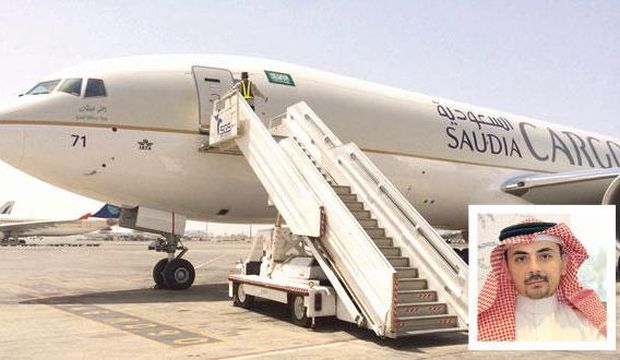
A Saudia Cargo jet is seen on the tarmac, (inset) Saudia Cargo Chief Executive Nabil Khoja. (Asharq Al-Awsat)
Jeddah, Asharq Al-Awsat—Saudia Cargo confirmed the delivery of a new Boeing 777 aircraft this month to expand its fleet to 13 planes, part of plans to outcompete other carriers from the Gulf, Saudia Cargo’s Chief Executive Nabil Khoja said.
Khoja said Saudia Cargo, the Saudi national carrier’s air cargo arm, is also expecting the delivery of another three Boeing 777s, though he did not specify when the new planes would arrive.
The new arrivals are part of the company’s strategic plan to secure a larger slice of the fast-growing air cargo market in the Gulf.
Global passenger carriers are facing stiff competition from Middle Eastern airlines such as Emirates, Etihad and Qatar Airways, but data suggests air cargo companies from the region are also beginning to outshine their global competitors.
Figures released by the International Air Transport Association (IATA) earlier this month showed Middle Eastern cargo carrier volumes grew by 10.6 percent year-on-year this March, compared to the global average of 1.6 percent globally for the same period. Middle Eastern carriers grew their total capacity by 17.1 percent since March of 2014.
European carriers, meanwhile, saw a decline in total volumes of 2.4 percent this March compared to the same period last year, while their North American counterparts reported modest growth in volumes of 0.8 percent for the same period. Total capacity in both regions expanded by 2.3 percent and declined 3.1 percent, respectively.
The growth in the Middle East region was largely fueled by network and capacity expansion among the region’s carriers, as well as an increase in trade among regional economies, IATA said.
Seventy percent of the region’s air freight passes through the Kingdom, according to Suleiman Abdullah Al-Hamdan, the head of Saudi Arabia’s General Authority of Civil Aviation (GACA).
Saudia Cargo’s fleet expansion comes as the Kingdom opened its first air cargo village last month—in a highly publicized bid to compete with the Dubai International Airport Cargo Gateway.
Handling some 1.8 million tons of cargo per year, the Dubai facility is the largest in the Gulf region, and the eighth-largest globally.
Saudi Arabia’s new 598,000-square-yard (500,000-square-meter) cargo village will be located at the King Fahd International Airport in the eastern city of Dammam. Global couriers such as DHL and UPS have already set up facilities and offices at the villages, according to the Saudi Gazette.
